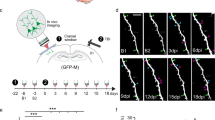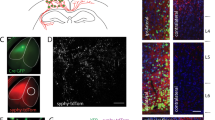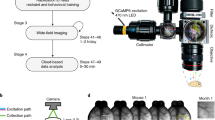Abstract
Determining the degree of synapse formation and elimination is essential for understanding the structural basis of brain plasticity and pathology. We show that in vivo imaging of dendritic spine dynamics through an open-skull glass window, but not a thinned-skull window, is associated with high spine turnover and substantial glial activation during the first month after surgery. These findings help to explain existing discrepancies in the degree of dendritic spine plasticity observed in the mature cortex.
This is a preview of subscription content, access via your institution
Access options
Subscribe to this journal
Receive 12 print issues and online access
$209.00 per year
only $17.42 per issue
Buy this article
- Purchase on Springer Link
- Instant access to full article PDF
Prices may be subject to local taxes which are calculated during checkout


Similar content being viewed by others
References
Grutzendler, J., Kasthuri, N. & Gan, W.B. Nature 420, 812–816 (2002).
Holtmaat, A., Wilbrecht, L., Knott, G.W., Welker, E. & Svoboda, K. Nature 441, 979–983 (2006).
Holtmaat, A.J. et al. Neuron 45, 279–291 (2005).
Trachtenberg, J.T. et al. Nature 420, 788–794 (2002).
Zuo, Y., Yang, G., Kwon, E. & Gan, W.B. Nature 436, 261–265 (2005).
Zuo, Y., Lin, A., Chang, P. & Gan, W.B. Neuron 46, 181–189 (2005).
Meyer, M.P., Niell, C.M. & Smith, S.J. Curr. Biol. 13, R180–R182 (2003).
Ottersen, O.P. & Helm, P.J. Nature 420, 751–752 (2002).
Allen, N.J. & Barres, B.A. Curr. Opin. Neurobiol. 15, 542–548 (2005).
Bruce-Keller, A.J. J. Neurosci. Res. 58, 191–201 (1999).
Stellwagen, D. & Malenka, R.C. Nature 440, 1054–1059 (2006).
Plock, N. & Kloft, C. Eur. J. Pharm. Sci. 25, 1–24 (2005).
Super, H. & Roelfsema, P.R. Prog. Brain Res. 147, 263–282 (2005).
Navari, R.M., Wei, E.P., Kontos, H.A. & Patterson, J.L., Jr . Microvasc. Res. 16, 304–315 (1978).
Polikov, V.S., Tresco, P.A. & Reichert, W.M. J. Neurosci. Methods 148, 1–18 (2005).
Acknowledgements
We thank N. Kasthuri, J. Grutzendler and K. Helmin for critical comments on this manuscript. This work was supported by grants from the US National Institutes of Health (W.-B.G.).
Author information
Authors and Affiliations
Contributions
H.-T.X., F.P. and G.Y. contributed equally to this work. All of the authors contributed to the experimental design. G.Y., F.P. and H.-T.X. did the in vivo imaging experiments and the data analysis. H.-T.X. did the immunostaining and imaging of glial cells. W.-B.G. initiated the project, contributed to the initial experiments and wrote the manuscript. H.-T.X., F.P. and G.Y. discussed the results, made the figures and commented on the manuscript.
Corresponding author
Ethics declarations
Competing interests
The authors declare no competing financial interests.
Supplementary information
Supplementary Fig. 1
Survival fraction of dendritic spines from individual mice under open-skull or thinned-skull windows. (PDF 606 kb)
Supplementary Fig. 2
Reduction in spine density in the first 2 weeks after open-skull surgery. (PDF 609 kb)
Supplementary Fig. 3
Additional examples showing microglial activation under open-skull windows, but not thinned skull windows. (PDF 2337 kb)
Supplementary Fig. 4
Additional examples showing astrocyte activation under the open-skull window, but not the thinned skull window. (PDF 1214 kb)
Supplementary Fig. 5
Astrocyte activation continues 20–30 d after open-skull surgery. (PDF 1097 kb)
Supplementary Table 1
Microglia density quantification 10 d after surgery. (PDF 283 kb)
Rights and permissions
About this article
Cite this article
Xu, HT., Pan, F., Yang, G. et al. Choice of cranial window type for in vivo imaging affects dendritic spine turnover in the cortex. Nat Neurosci 10, 549–551 (2007). https://doi.org/10.1038/nn1883
Received:
Accepted:
Published:
Issue Date:
DOI: https://doi.org/10.1038/nn1883
This article is cited by
-
Shape-changing electrode array for minimally invasive large-scale intracranial brain activity mapping
Nature Communications (2024)
-
Intravital imaging to study cancer progression and metastasis
Nature Reviews Cancer (2023)
-
Fluorescence-amplified nanocrystals in the second near-infrared window for in vivo real-time dynamic multiplexed imaging
Nature Nanotechnology (2023)
-
Deep tissue multi-photon imaging using adaptive optics with direct focus sensing and shaping
Nature Biotechnology (2022)
-
Two-photon calcium imaging of neuronal activity
Nature Reviews Methods Primers (2022)



